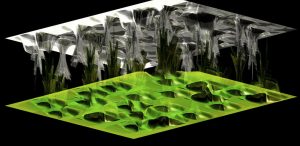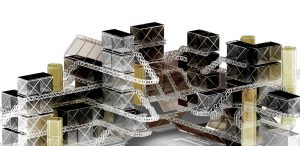
Michael Hansmeyer’s L-Systems in Architecture explores the possibilities that L-Systems can open up in architecture. L-Systems is a string-rewriting algorithm that was created by biologist Aristid Lindenmayer. Lindenmayer created this algorithm to model simplified plants and their growth processes. Hansmeyer’s is an architect and programmer. His interests lie in the idea that architecture should be judged by the experiences that it produces. He takes advantage of computational methods to enhance these experiences intellectually and sensually.
There are two parts to the project. The first half explores which qualities of a design are essential to the logic of the algorithm. It considers methods for visualizing L-Systems. The second half incorporates aspects of parametric systems to expand the algorithm’s language. This part of the project explores the different ways that the L-System can react to its environment and how these adaptations can physically be applied to architectural design.
Nature has been the muse of many architects due to it’s forms and geometries. Many times the product of nature’s inspiration is executed too literally. Hansmeyer utilizes these characteristics as ways to improve the function of a building rather than to solely determine it’s form.


![[OLD FALL 2017] 15-104 • Introduction to Computing for Creative Practice](wp-content/uploads/2020/08/stop-banner.png)